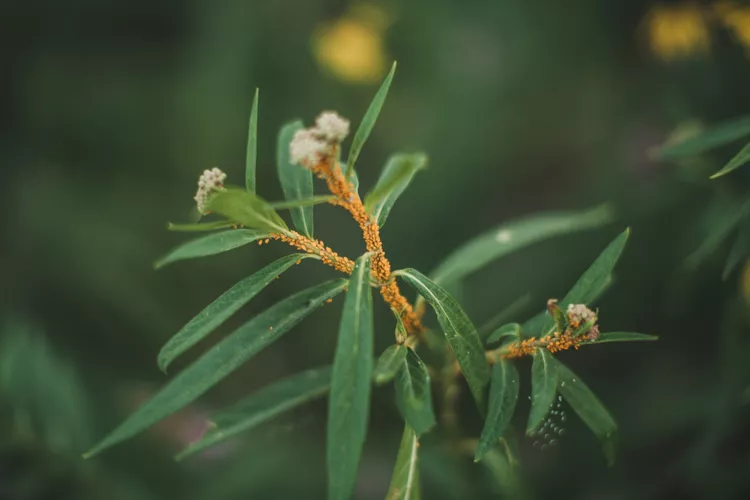6 Ways to Get Rid of Aphids on Milkweed Without Harming Monarchs

Bright orange milkweed aphids (Aphis nerii) usually emerge toward the end of summer and feed in clusters on the stems and leaves of common milkweed, swamp milkweed, and other milkweed plants. However, while garden aphids often spell disaster for vegetables and flowers, milkweed aphids usually don’t do much damage, and pest control treatments can do more harm than good. If you grow milkweed for monarch butterflies or simply want to protect your milkweed plants from harm, here’s how to get rid of aphids on milkweed in a monarch-safe way.
What Are Milkweed Aphids?
Also known as oleander aphids, milkweed aphids are not native to North America; they originated in the Mediterranean region. In their native land, these aphids primarily fed on oleander plants, but in North America, they usually target types of milkweed and dogbane.
While other aphid species come in assorted shades of green, brown, yellow, and black, milkweed aphids are always bright yellow or orange with black legs and black spikes, or “cornicles,” on their rears. Like other aphids, milkweed aphids typically feed in clusters on plant stems and leaves, and they can cause milkweed flowers and leaves to distort in shape. These aphids may also leave a sticky honeydew residue in their wake, which can develop sooty mold and make affected plants look like they’re coated in a fine, dark powder.
Are Aphids on Milkweed Harmful?
Because milkweed aphids don't do much harm to milkweed, it’s generally best to leave them right where they are. These aphids primarily target milkweed plants so treating infestations can harm the pollinators that depend on milkweed for survival, including monarch butterflies and bees. In addition, damage from milkweed aphids is usually insignificant, and they typically disappear on their own as soon as temperatures drop in fall.
If you’re growing milkweed for monarchs and are worried that aphids will interfere with monarch caterpillars, don’t fret. Although these aphids can compete with monarch caterpillars for milkweed, they don’t directly harm monarch caterpillars or monarch eggs. These two species usually coexist just fine. Milkweed aphids are typically much less damaging to monarchs than pest control treatments, including organic treatment protocols.
Ways to Get Rid of Aphids on Milkweed
Although it’s usually best to avoid treating aphids on milkweed, treatment may be in order if your milkweed plants look severely stressed. To keep monarchs and other pollinators safe, skip pesticides and soap sprays and try these aphid control strategies instead:
1. Try handpicking.
One of the fastest ways to get rid of milkweed aphids is to prune away heavily-infested leaves and then crush any aphids left on the plant with your fingers. Be sure to check for monarch caterpillars and eggs before you get to work, and inspect the plant stems and the undersides of the leaves for cleverly hidden aphids. This task can get messy, so put on gardening gloves before you start.
2. Rinse the plants with water.
Washing milkweed plants with a strong blast from the garden hose can dislodge milkweed aphids and reduce heavy infestations. However, water can also wash away monarch eggs and caterpillars, so this method is not recommended if you know monarchs are present.
3. Experiment with companion plants.
Some flowers and scented herbs can be used as companion plants to naturally repel aphids, while others function as trap crops by luring aphids away from milkweed. Some of the best plants to grow near milkweed for aphid control are marigolds, alliums, nasturtiums, dill, catnip, and anise.
4. Rely on beneficial insects.
Growing the right companion plants near milkweed can entice ladybugs, lacewings, and other beneficial insects to visit and feast on aphids. If you’re in a pinch and dealing with a heavy infestation of aphids, you can purchase ladybugs and lacewings from garden centers and release them directly onto your milkweed plants. Just know that they may not stick around.
5. Stop fertilizing.
Fertilizer encourages plants to produce new leaves, which is usually good, but if you’re combating milkweed aphids, avoid using any fertilizer. Not only are milkweed plants light feeders, but fertilizing them can cause them sprout new leaves and attract more aphids.
6. Boost plant health.
Healthy milkweed plants can withstand an invasion of aphids. So, if you want to keep aphids at bay, grow the right types of milkweed for your garden and provide the plants with the care they need. Most milkweed plants grow best in full sun, while common milkweed is happiest in well-draining soil, and swamp milkweed may become stressed and prone to aphids if it’s not grown in moist earth.